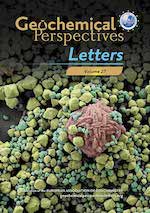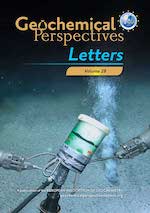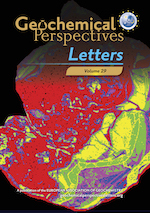Melting experiments on Fe-C-O to 200 GPa; liquidus phase constraints on core composition
Affiliations | Corresponding Author | Cite as | Funding information- Share this article





Article views:2,033Cumulative count of HTML views and PDF downloads.
- Download Citation
- Rights & Permissions
top
Abstract
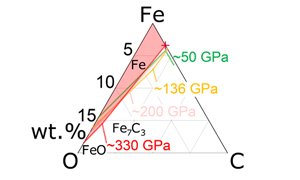
Figures
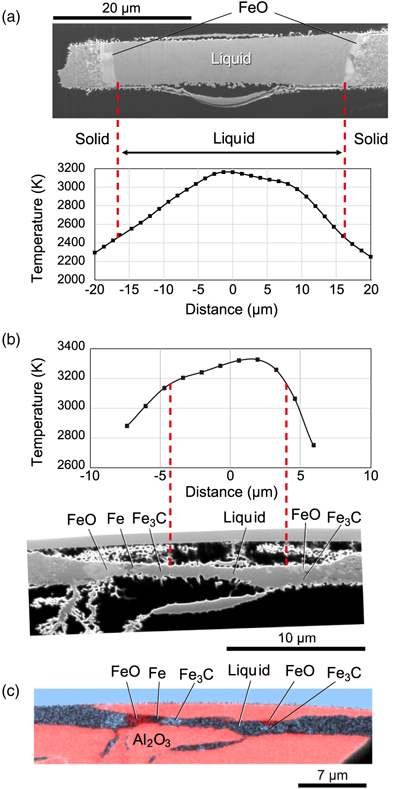 Figure 1 Scanning ion microscope (SIM) images and the X-ray elemental map of sample cross sections and corresponding temperature profiles obtained in (a) run #1 at 46 GPa and (b, c) run #3 at 128 GPa. The X-ray map (c) is combined for C (light blue), O (red), and Al (white). In run #3, we found Fe3C and FeO in direct contact with liquid at 3170 K and Fe at a slightly lower temperature portion (3040 K), suggesting that the liquid obtained closely represents the ternary eutectic liquid at ∼3110 K. | 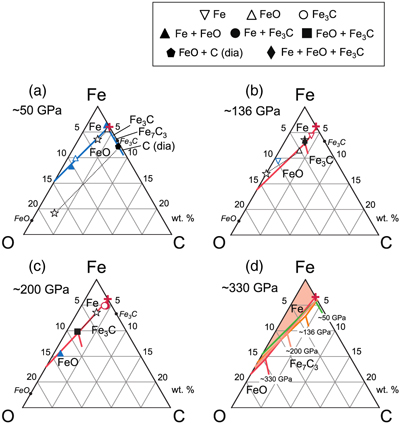 Figure 2 Liquidus phase relations of the Fe-C-O ternary system in weight percent at (a) ∼50 GPa, (b) ∼136 GPa, (c) ∼200 GPa, and (d) ∼330 GPa. Liquids obtained in the present experiments (black) are plotted along with those from Oka et al. (2019) (blue) and Mashino et al. (2019) (red). Pluses indicate the Fe-C binary eutectic composition at each pressure. Stars show the compositions of starting materials and are connected by dotted lines to those of liquids formed. Contamination by carbon explains the mass balance in each run. The present results indicate higher O concentration in the Fe-FeO eutectic liquid than earlier studies in which the presence of C in liquid was not quantitatively taken into account (Morard et al., 2017; Oka et al., 2019). Since the inner core consists of light element depleted solid Fe, the outer core composition should be in the liquidus field of Fe at inner core pressures as shown by the red area in (d) for 330 GPa. | 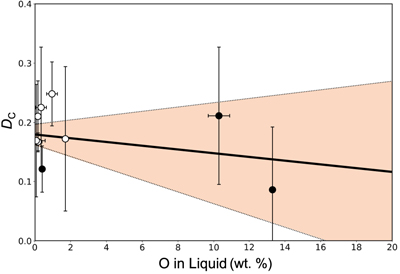 Figure 3 The solid Fe/liquid partition coefficient of C, DC plotted as a function of O concentration in liquid, calculated by weight percent. Solid and open circles indicate data obtained in this study and Mashino et al. (2019), respectively. The regression line is based on maximum likelihood estimation with weighting based on the inverse of uncertainty in each data; DC = −0.003(7) × [O]liq + 0.18(2). The shaded band indicates ±1σ uncertainty. | 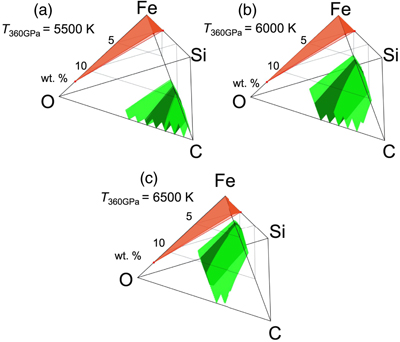 Figure 4 Compositional range of liquids (green) that are in equilibrium with the Fe-C-Si-1.4 wt. % S solids for the inner core proposed by Li et al. (2018). Green and dark green areas indicate compositions estimated using DC with and without ±1σ uncertainty, respectively. T360 GPa = 5500 K (a), 6000 K (b), and 6500 K (c). The O contents are calculated to account for the outer density and velocity at corresponding TICB = 5320 K, 5800 K, and 6280 K (Umemoto and Hirose, 2020). The red area shows the liquidus field of Fe in the Fe-C-O-Si-1.7 wt. % S system. There are no Fe-C-O-Si-1.7 wt. % S liquids that satisfy both the seismological (green) and liquidus phase (red) constraints. |
| Figure 1 | Figure 2 | Figure 3 | Figure 4 |
top
Introduction
The ∼8 % density deficit and ∼4 % velocity excess of the Earth’s outer core with respect to pure Fe (Kuwayama et al., 2020
Kuwayama, Y., Morard, G., Nakajima, Y., Hirose, K., Baron, A.Q.R., Kawaguchi, S.I., Tsuchiya, T., Ishikawa, D., Hirao, N., Ohishi, Y. (2020) Equation of state of liquid iron under extreme conditions. Physical Review Letters 124, 165701. https://doi.org/10.1103/PhysRevLett.124.165701
) are attributed to the presence of light elements such as C, O, S, Si, and H (e.g., Hirose et al., 2021Hirose, K., Wood, B., Vočadlo, L. (2021) Light elements in the Earth’s core. Nature Reviews Earth & Environment 2, 645–658. https://doi.org/10.1038/s43017-021-00203-6
). The recent ab initio simulations by Li et al. (2018)Li, Y., Vočadlo, L., Brodholt, J.P. (2018) The elastic properties of hcp-Fe alloys under the conditions of the Earth’s inner core. Earth and Planetary Science Letters 493, 118–127. https://doi.org/10.1016/j.epsl.2018.04.013
showed a possible range of the solid inner composition in the Fe-C-S-Si system and argued that C is essential to explain the density, and compressional and shear velocities, observed in the inner core. It suggests that the outer core is also rich in C when considering its low solid metal/liquid metal partition coefficients obtained in the Fe-C system (Mashino et al., 2019Mashino, I., Miozzi, F., Hirose, K., Morard, G., Sinmyo, R. (2019) Melting experiments on the Fe–C binary system up to 255 GPa: Constraints on the carbon content in the Earth’s core. Earth and Planetary Science Letters 515, 135–144. https://doi.org/10.1016/j.epsl.2019.03.020
). Contrarily, O is known to be almost insoluble in solid Fe (Alfè et al., 2002Alfè, D., Gillan, M.J., Price, G.D. (2002) Composition and temperature of the Earth’s core constrained by combining ab initio calculations and seismic data. Earth and Planetary Science Letters 195, 91–98. https://doi.org/10.1016/S0012-821X(01)00568-4
) and should thus be nearly absent in the inner core. Instead, O can account for the density difference observed across the inner core boundary (ICB) (Alfè et al., 2002Alfè, D., Gillan, M.J., Price, G.D. (2002) Composition and temperature of the Earth’s core constrained by combining ab initio calculations and seismic data. Earth and Planetary Science Letters 195, 91–98. https://doi.org/10.1016/S0012-821X(01)00568-4
; Kuwayama et al., 2020Kuwayama, Y., Morard, G., Nakajima, Y., Hirose, K., Baron, A.Q.R., Kawaguchi, S.I., Tsuchiya, T., Ishikawa, D., Hirao, N., Ohishi, Y. (2020) Equation of state of liquid iron under extreme conditions. Physical Review Letters 124, 165701. https://doi.org/10.1103/PhysRevLett.124.165701
) and is likely to be a major light element in the outer core (Badro et al., 2014Badro, J., Cote, A.S., Brodholt, J.P. (2014) A seismologically consistent compositional model of Earth’s core. Proceedings of the National Academy of Sciences 111, 7542–7545. https://doi.org/10.1073/pnas.1316708111
; Umemoto and Hirose, 2020Umemoto, K., Hirose, K. (2020) Chemical compositions of the outer core examined by the first principles calculations. Earth and Planetary Science Letters 531, 116009. https://doi.org/10.1016/j.epsl.2019.116009
). Both C and O could thus be important light elements in the core. Morard et al. (2017)Morard, G., Andrault, D., Antonangeli, D., Nakajima, Y., Auzende, A.L., Boulard, E., Cervera, S., Clark, A., Lord, O.T., Siebert, J., Svitlyk, V., Garbarino, G., Mezouar, M. (2017) Fe–FeO and Fe–Fe3C melting relations at Earth’s core–mantle boundary conditions: Implications for a volatile-rich or oxygen-rich core. Earth and Planetary Science Letters 473, 94–103. https://doi.org/10.1016/j.epsl.2017.05.024
argued that both C and O largely diminish the liquidus temperatures of Fe alloys, which is important for the core-mantle boundary (CMB) temperature to be lower than the melting temperature of the lowermost mantle.Melting phase relations and eutectic liquid compositions have been examined in Fe-rich portions of both the Fe-C (Mashino et al., 2019
Mashino, I., Miozzi, F., Hirose, K., Morard, G., Sinmyo, R. (2019) Melting experiments on the Fe–C binary system up to 255 GPa: Constraints on the carbon content in the Earth’s core. Earth and Planetary Science Letters 515, 135–144. https://doi.org/10.1016/j.epsl.2019.03.020
) and Fe-O binary systems (Oka et al., 2019Oka, K., Hirose, K., Tagawa, S., Kidokoro, Y., Nakajima, Y., Kuwayama, Y., Morard, G., Coudurier, N., Fiquet, G. (2019) Melting in the Fe-FeO system to 204 GPa: Implications for oxygen in Earth’s core. American Mineralogist 104, 1603–1607. https://doi.org/10.2138/am-2019-7081
), but those in the Fe-C-O ternary systems are not known yet. When two or more light elements are present, interactions between them affect phase relations and element partitioning in ternary systems. The composition of the outer core liquid should be within the liquidus field of Fe such that it crystallises the dense inner core.Here we performed melting experiments on the Fe-C-O system at high pressure and temperature (P-T) in a laser heated diamond-anvil cell (DAC) (see Supplementary Information S-1 for Methods) and determined the ternary liquidus phase relations and solid-liquid partitioning based on the textural and chemical analyses of recovered samples at ∼50 (39–49) GPa, ∼136 (128–138) GPa, and ∼200 (190–211) GPa. These results are then extrapolated to the ICB pressure of 330 GPa by employing earlier data on the Fe-C system (Mashino et al., 2019
Mashino, I., Miozzi, F., Hirose, K., Morard, G., Sinmyo, R. (2019) Melting experiments on the Fe–C binary system up to 255 GPa: Constraints on the carbon content in the Earth’s core. Earth and Planetary Science Letters 515, 135–144. https://doi.org/10.1016/j.epsl.2019.03.020
). The range of the possible inner core composition in the Fe-C-S-Si system has been recently proposed by Li et al. (2018)Li, Y., Vočadlo, L., Brodholt, J.P. (2018) The elastic properties of hcp-Fe alloys under the conditions of the Earth’s inner core. Earth and Planetary Science Letters 493, 118–127. https://doi.org/10.1016/j.epsl.2018.04.013
. We examine the validity of such Fe-C-S-Si inner core and suggest that H may be an additional important light element not only in the outer core (Umemoto and Hirose, 2020Umemoto, K., Hirose, K. (2020) Chemical compositions of the outer core examined by the first principles calculations. Earth and Planetary Science Letters 531, 116009. https://doi.org/10.1016/j.epsl.2019.116009
) but also in the inner core (Wang et al., 2021Wang, W., Li, Y., Brodholt, J.P., Vočadlo, L., Walter, M.J., Wu, Z. (2021) Strong shear softening induced by superionic hydrogen in Earth’s inner core. Earth and Planetary Science Letters 568, 117014. https://doi.org/10.1016/j.epsl.2021.117014
).top
Results
We performed five separate melting experiments on three samples with different C/O ratios at pressures around 50 GPa, 136 GPa, and 200 GPa (Table S-1). From the textural and compositional characterisations of sample cross sections, we determined liquid compositions and their liquidus phases (Figs. 1, S-1; Supplementary Information S-2). The Fe-C-O ternary diagrams were obtained at each pressure based on these present data along with those reported in Mashino et al. (2019)
Mashino, I., Miozzi, F., Hirose, K., Morard, G., Sinmyo, R. (2019) Melting experiments on the Fe–C binary system up to 255 GPa: Constraints on the carbon content in the Earth’s core. Earth and Planetary Science Letters 515, 135–144. https://doi.org/10.1016/j.epsl.2019.03.020
and Oka et al. (2019)Oka, K., Hirose, K., Tagawa, S., Kidokoro, Y., Nakajima, Y., Kuwayama, Y., Morard, G., Coudurier, N., Fiquet, G. (2019) Melting in the Fe-FeO system to 204 GPa: Implications for oxygen in Earth’s core. American Mineralogist 104, 1603–1607. https://doi.org/10.2138/am-2019-7081
, both of which reported the EPMA analyses of C and O concentrations in liquids along with their liquidus phases. We employ the Fe-C binary eutectic composition at each pressure from Mashino et al. (2019)Mashino, I., Miozzi, F., Hirose, K., Morard, G., Sinmyo, R. (2019) Melting experiments on the Fe–C binary system up to 255 GPa: Constraints on the carbon content in the Earth’s core. Earth and Planetary Science Letters 515, 135–144. https://doi.org/10.1016/j.epsl.2019.03.020
considering uncertainty in their determinations (see red pluses in Fig. 2).
Figure 1 Scanning ion microscope (SIM) images and the X-ray elemental map of sample cross sections and corresponding temperature profiles obtained in (a) run #1 at 46 GPa and (b, c) run #3 at 128 GPa. The X-ray map (c) is combined for C (light blue), O (red), and Al (white). In run #3, we found Fe3C and FeO in direct contact with liquid at 3170 K and Fe at a slightly lower temperature portion (3040 K), suggesting that the liquid obtained closely represents the ternary eutectic liquid at ∼3110 K.

Figure 2 Liquidus phase relations of the Fe-C-O ternary system in weight percent at (a) ∼50 GPa, (b) ∼136 GPa, (c) ∼200 GPa, and (d) ∼330 GPa. Liquids obtained in the present experiments (black) are plotted along with those from Oka et al. (2019)
Oka, K., Hirose, K., Tagawa, S., Kidokoro, Y., Nakajima, Y., Kuwayama, Y., Morard, G., Coudurier, N., Fiquet, G. (2019) Melting in the Fe-FeO system to 204 GPa: Implications for oxygen in Earth’s core. American Mineralogist 104, 1603–1607. https://doi.org/10.2138/am-2019-7081
(blue) and Mashino et al. (2019)Mashino, I., Miozzi, F., Hirose, K., Morard, G., Sinmyo, R. (2019) Melting experiments on the Fe–C binary system up to 255 GPa: Constraints on the carbon content in the Earth’s core. Earth and Planetary Science Letters 515, 135–144. https://doi.org/10.1016/j.epsl.2019.03.020
(red). Pluses indicate the Fe-C binary eutectic composition at each pressure. Stars show the compositions of starting materials and are connected by dotted lines to those of liquids formed. Contamination by carbon explains the mass balance in each run. The present results indicate higher O concentration in the Fe-FeO eutectic liquid than earlier studies in which the presence of C in liquid was not quantitatively taken into account (Morard et al., 2017Morard, G., Andrault, D., Antonangeli, D., Nakajima, Y., Auzende, A.L., Boulard, E., Cervera, S., Clark, A., Lord, O.T., Siebert, J., Svitlyk, V., Garbarino, G., Mezouar, M. (2017) Fe–FeO and Fe–Fe3C melting relations at Earth’s core–mantle boundary conditions: Implications for a volatile-rich or oxygen-rich core. Earth and Planetary Science Letters 473, 94–103. https://doi.org/10.1016/j.epsl.2017.05.024
; Oka et al., 2019Oka, K., Hirose, K., Tagawa, S., Kidokoro, Y., Nakajima, Y., Kuwayama, Y., Morard, G., Coudurier, N., Fiquet, G. (2019) Melting in the Fe-FeO system to 204 GPa: Implications for oxygen in Earth’s core. American Mineralogist 104, 1603–1607. https://doi.org/10.2138/am-2019-7081
). Since the inner core consists of light element depleted solid Fe, the outer core composition should be in the liquidus field of Fe at inner core pressures as shown by the red area in (d) for 330 GPa.At ∼50 GPa, the Fe-C-O liquids containing only 0.4–0.6 wt. % O coexisted with FeO, indicating that the liquidus field of FeO extends to a low O portion (Fig. 2a). Moreover, the compositions of liquids coexisting with FeO ± Fe (runs #1 and #O7) are close to that of the Fe-C binary eutectic liquid that coexists with Fe + Fe3C (Mashino et al., 2019
Mashino, I., Miozzi, F., Hirose, K., Morard, G., Sinmyo, R. (2019) Melting experiments on the Fe–C binary system up to 255 GPa: Constraints on the carbon content in the Earth’s core. Earth and Planetary Science Letters 515, 135–144. https://doi.org/10.1016/j.epsl.2019.03.020
), suggesting that they approximate the ternary eutectic composition at this pressure. The Fe + FeO cotectic line and the C-free, Fe-FeO binary eutectic composition are obtained by combining such ternary eutectic composition with those of O-rich (8.8–10.3 wt. %) liquids coexisting with FeO ± Fe (runs #O3 and #O4).At ∼136 GPa (Fig. 2b), we obtained the ternary eutectic liquid which coexisted with Fe + FeO + Fe3C (run #3; Fig. 1b,c). The Fe + Fe3C cotectic line is drawn between the ternary eutectic and the Fe-C binary eutectic compositions (Mashino et al., 2019
Mashino, I., Miozzi, F., Hirose, K., Morard, G., Sinmyo, R. (2019) Melting experiments on the Fe–C binary system up to 255 GPa: Constraints on the carbon content in the Earth’s core. Earth and Planetary Science Letters 515, 135–144. https://doi.org/10.1016/j.epsl.2019.03.020
) and is consistent with the liquid composition obtained in run #M3 coexisting with Fe. The Fe-FeO binary eutectic composition was found at ∼50 GPa and ∼200 GPa from the positions of the Fe + FeO cotectic line in the Fe-C-O ternary diagrams and is estimated for ∼136 GPa by interpolation considering the pressure effect works linearly, based on the previous observations that the Fe-FeO eutectic composition increases approximately in proportion to pressure above 50 GPa (Oka et al., 2019Oka, K., Hirose, K., Tagawa, S., Kidokoro, Y., Nakajima, Y., Kuwayama, Y., Morard, G., Coudurier, N., Fiquet, G. (2019) Melting in the Fe-FeO system to 204 GPa: Implications for oxygen in Earth’s core. American Mineralogist 104, 1603–1607. https://doi.org/10.2138/am-2019-7081
). The Fe + FeO cotectic line obtained at this pressure is compatible with the results of runs #4 and #O5. Also at ∼200 GPa (Fig. 2c), we obtained an Fe-C-O liquid coexisting with FeO + Fe3C in run #5 in addition to those from runs #M4, #M7, and #O6. This liquid should almost represent the ternary eutectic liquid since its composition is plotted near the tie line between those of the Fe-C eutectic liquid and the liquid coexisting with Fe + FeO (run #O6).These results well constrain the Fe-C-O ternary liquidus phase diagram at ∼50 GPa, ∼136 GPa, and ∼200 GPa (Fig. 2a–c). The ternary eutectic temperature is found to be about 2460 ± 110 K at ∼50 GPa (run #1), 3110 ± 150 K at ∼136 GPa (run #3), and 3660 ±240 K at ∼200 GPa (run #5), and they are extrapolated to ∼4100 K at the ICB pressure (Fig. S-2). Figure 2d shows the liquidus phase relations at 330 GPa, in which we employed the C concentration in the Fe-C binary eutectic liquid (Mashino et al., 2019
Mashino, I., Miozzi, F., Hirose, K., Morard, G., Sinmyo, R. (2019) Melting experiments on the Fe–C binary system up to 255 GPa: Constraints on the carbon content in the Earth’s core. Earth and Planetary Science Letters 515, 135–144. https://doi.org/10.1016/j.epsl.2019.03.020
) and extrapolated the ternary eutectic liquid composition and the O content (∼18 wt. %) in the Fe-O eutectic liquid by considering the linear pressure effect above 50 GPa where mixing between the Fe-rich metallic liquid and FeO-rich ionic liquid becomes ideal (Oka et al., 2019Oka, K., Hirose, K., Tagawa, S., Kidokoro, Y., Nakajima, Y., Kuwayama, Y., Morard, G., Coudurier, N., Fiquet, G. (2019) Melting in the Fe-FeO system to 204 GPa: Implications for oxygen in Earth’s core. American Mineralogist 104, 1603–1607. https://doi.org/10.2138/am-2019-7081
). It is noted that the ternary eutectic composition is located close to the tie line connecting the Fe-Fe3C and Fe-FeO binary eutectic compositions at each pressure. In other words, the liquidus field of Fe, a compositional range of liquids that first crystallise Fe rather than light element-rich phases of Fe3C (or Fe7C3 above 203–255 GPa according to Mashino et al., 2019Mashino, I., Miozzi, F., Hirose, K., Morard, G., Sinmyo, R. (2019) Melting experiments on the Fe–C binary system up to 255 GPa: Constraints on the carbon content in the Earth’s core. Earth and Planetary Science Letters 515, 135–144. https://doi.org/10.1016/j.epsl.2019.03.020
) and FeO, can be estimated by interpolation between the Fe-C and Fe-O eutectic liquid compositions.top
Discussion
Fe-C-O or Fe-C-O-S-Si outer core? If the outer core is an Fe-C-O liquid, it crystallises the Fe-C inner core because a negligible amount of O can be included in solid Fe (Alfè et al., 2002
Alfè, D., Gillan, M.J., Price, G.D. (2002) Composition and temperature of the Earth’s core constrained by combining ab initio calculations and seismic data. Earth and Planetary Science Letters 195, 91–98. https://doi.org/10.1016/S0012-821X(01)00568-4
; Yokoo et al., 2019Yokoo, S., Hirose, K., Sinmyo, R., Tagawa, S. (2019) Melting Experiments on Liquidus Phase Relations in the Fe-S-O Ternary System Under Core Pressures. Geophysical Research Letters 46, 5137–5145. https://doi.org/10.1029/2019GL082277
). C alone cannot account for the observed density and velocities (Li et al., 2018Li, Y., Vočadlo, L., Brodholt, J.P. (2018) The elastic properties of hcp-Fe alloys under the conditions of the Earth’s inner core. Earth and Planetary Science Letters 493, 118–127. https://doi.org/10.1016/j.epsl.2018.04.013
). It is likely that 1.7 wt. % S is present in the outer core according to cosmochemical and geochemical studies (Dreibus and Palme, 1996Dreibus, G., Palme, H. (1996) Cosmochemical constraints on the sulfur content in the Earth’s core. Geochimica et Cosmochimica Acta 60, 1125–1130. https://doi.org/10.1016/0016-7037(96)00028-2
). When we apply the solid Fe/liquid partition coefficient of sulfur, DS = 0.8 (by weight) at 330 GPa determined by both theory (Alfè et al., 2002Alfè, D., Gillan, M.J., Price, G.D. (2002) Composition and temperature of the Earth’s core constrained by combining ab initio calculations and seismic data. Earth and Planetary Science Letters 195, 91–98. https://doi.org/10.1016/S0012-821X(01)00568-4
) and experiment (Yokoo et al., 2019Yokoo, S., Hirose, K., Sinmyo, R., Tagawa, S. (2019) Melting Experiments on Liquidus Phase Relations in the Fe-S-O Ternary System Under Core Pressures. Geophysical Research Letters 46, 5137–5145. https://doi.org/10.1029/2019GL082277
), the inner core may include 1.4 wt. % S in addition to C. The recent ab initio calculations gave possible C concentrations in solid Fe-C-1.4 wt. % S alloys that explain the inner core density, compressional and shear velocities (the Fortran code provided in Li et al., 2018Li, Y., Vočadlo, L., Brodholt, J.P. (2018) The elastic properties of hcp-Fe alloys under the conditions of the Earth’s inner core. Earth and Planetary Science Letters 493, 118–127. https://doi.org/10.1016/j.epsl.2018.04.013
); 1.5–2.3, 1.0–1.6, and 0.7–1.1 wt. % C for T360GPa = 5500, 6000, and 6500 K, respectively. We can calculate the C contents in Fe-C-O-1.7 wt. % S liquids that are in equilibrium with such Fe-C-1.4 wt. % S solids at the ICB with DC that depends on the amount of O (Fig. 3; Supplementary Information S-3). Regardless of the O content, such liquid compositions are, however, far outside the liquidus field of Fe in the Fe-C-O-1.7 wt. % S system at inner core conditions (Fig. S-3), which is estimated considering 5 wt. % S in the Fe-S binary eutectic liquid at 330 GPa (Mori et al., 2017Mori, Y., Ozawa, H., Hirose, K., Sinmyo, R., Tateno, S., Morard, G., Ohishi, Y. (2017) Melting experiments on Fe–Fe3S system to 254 GPa. Earth and Planetary Science Letters 464, 135–141. https://doi.org/10.1016/j.epsl.2017.02.021
) (see Supplementary Information S-4). The Fe-C-1.4 wt. % S inner core (and Fe-C-O-1.7 wt. % S outer core) is therefore not feasible.
Figure 3 The solid Fe/liquid partition coefficient of C, DC plotted as a function of O concentration in liquid, calculated by weight percent. Solid and open circles indicate data obtained in this study and Mashino et al. (2019)
Mashino, I., Miozzi, F., Hirose, K., Morard, G., Sinmyo, R. (2019) Melting experiments on the Fe–C binary system up to 255 GPa: Constraints on the carbon content in the Earth’s core. Earth and Planetary Science Letters 515, 135–144. https://doi.org/10.1016/j.epsl.2019.03.020
, respectively. The regression line is based on maximum likelihood estimation with weighting based on the inverse of uncertainty in each data; DC = −0.003(7) × [O]liq + 0.18(2). The shaded band indicates ±1σ uncertainty.Next we additionally consider the presence of Si. The range of solid Fe-C-Si-1.4 wt. % S compositions that satisfy the observed inner core density and velocities has been also calculated by Li et al. (2018)
Li, Y., Vočadlo, L., Brodholt, J.P. (2018) The elastic properties of hcp-Fe alloys under the conditions of the Earth’s inner core. Earth and Planetary Science Letters 493, 118–127. https://doi.org/10.1016/j.epsl.2018.04.013
at T360GPa = 5500, 6000, and 6500 K. The C and Si abundances in Fe-C-O-Si-1.7 wt. % S liquids which coexist with such Fe-C-Si-1.4 wt. % S solids at the ICB are calculated by employing DC and DSi (= 1.0) (Alfè et al., 2002Alfè, D., Gillan, M.J., Price, G.D. (2002) Composition and temperature of the Earth’s core constrained by combining ab initio calculations and seismic data. Earth and Planetary Science Letters 195, 91–98. https://doi.org/10.1016/S0012-821X(01)00568-4
). In addition, the remaining O content is obtained for the liquids Fe-C-O-Si-1.7 wt. % S to account for the outer density and velocity (Umemoto and Hirose, 2020Umemoto, K., Hirose, K. (2020) Chemical compositions of the outer core examined by the first principles calculations. Earth and Planetary Science Letters 531, 116009. https://doi.org/10.1016/j.epsl.2019.116009
) when TICB = 5320 K, 5800 K, and 6280 K that correspond respectively to 5500 K, 6000 K, and 6500 K at 360 GPa employed in Li et al. (2018)Li, Y., Vočadlo, L., Brodholt, J.P. (2018) The elastic properties of hcp-Fe alloys under the conditions of the Earth’s inner core. Earth and Planetary Science Letters 493, 118–127. https://doi.org/10.1016/j.epsl.2018.04.013
assuming adiabatic temperature profile and Grüneisen parameter γ = 1.5. On the other hand, we extend the estimate of the liquidus field of Fe to the Si-bearing system considering 8 wt. % Si in the Fe-Si binary eutectic liquid at 330 GPa (Hasegawa et al., 2021Hasegawa, M., Hirose, K., Oka, K., Ohishi, Y. (2021) Liquidus Phase Relations and Solid-Liquid Partitioning in the Fe-Si-C System Under Core Pressures. Geophysical Research Letters 48, e2021GL092681. https://doi.org/10.1029/2021GL092681
) (see Supplementary Information S-4). Nevertheless, the range of liquid compositions based on constraints from seismological observations of both the inner and outer core again do not overlap with the liquidus field of Fe in the Fe-C-O-Si-1.7 wt. % S system (Fig. 4).
Figure 4 Compositional range of liquids (green) that are in equilibrium with the Fe-C-Si-1.4 wt. % S solids for the inner core proposed by Li et al. (2018)
Li, Y., Vočadlo, L., Brodholt, J.P. (2018) The elastic properties of hcp-Fe alloys under the conditions of the Earth’s inner core. Earth and Planetary Science Letters 493, 118–127. https://doi.org/10.1016/j.epsl.2018.04.013
. Green and dark green areas indicate compositions estimated using DC with and without ±1σ uncertainty, respectively. T360 GPa = 5500 K (a), 6000 K (b), and 6500 K (c). The O contents are calculated to account for the outer density and velocity at corresponding TICB = 5320 K, 5800 K, and 6280 K (Umemoto and Hirose, 2020Umemoto, K., Hirose, K. (2020) Chemical compositions of the outer core examined by the first principles calculations. Earth and Planetary Science Letters 531, 116009. https://doi.org/10.1016/j.epsl.2019.116009
). The red area shows the liquidus field of Fe in the Fe-C-O-Si-1.7 wt. % S system. There are no Fe-C-O-Si-1.7 wt. % S liquids that satisfy both the seismological (green) and liquidus phase (red) constraints.Hydrogen in the core? None of the alloys in the Fe-C-O-S-Si system satisfy the liquidus phase constraint on core composition examined in this study in addition to the seismological constraints. This is primarily because high concentrations of C are required in the inner core when H is not considered (Li et al., 2018
Li, Y., Vočadlo, L., Brodholt, J.P. (2018) The elastic properties of hcp-Fe alloys under the conditions of the Earth’s inner core. Earth and Planetary Science Letters 493, 118–127. https://doi.org/10.1016/j.epsl.2018.04.013
), which leads to too much C in the outer core due to the low DC (= 0.1 to 0.2) (Fig. 3). It is likely that the inner core solid contains only a minor amount of C and may instead include a substantial amount of H. Indeed, the more recent ab initio simulations by Wang et al. (2021)Wang, W., Li, Y., Brodholt, J.P., Vočadlo, L., Walter, M.J., Wu, Z. (2021) Strong shear softening induced by superionic hydrogen in Earth’s inner core. Earth and Planetary Science Letters 568, 117014. https://doi.org/10.1016/j.epsl.2021.117014
demonstrated that solid Fe-Si-H alloys can explain the seismological observations of the inner core. The inclusion of H in the inner core requires its presence in the outer core as well. Indeed, it has been already supported by ab initio calculations of the density and compressional velocity of H-bearing liquid Fe alloys (Umemoto and Hirose, 2020Umemoto, K., Hirose, K. (2020) Chemical compositions of the outer core examined by the first principles calculations. Earth and Planetary Science Letters 531, 116009. https://doi.org/10.1016/j.epsl.2019.116009
) and by the high metal/silicate partition coefficient of H under high P-T conditions of core segregation (Li et al., 2020Li, Y., Vočadlo, L., Sun, T., Brodholt, J.P. (2020) The Earth’s core as a reservoir of water. Nature Geoscience 13, 453–458. https://doi.org/10.1038/s41561-020-0578-1
; Tagawa et al., 2021Tagawa, S., Sakamoto, N., Hirose, K., Yokoo, S., Hernlund, J., Ohishi, Y., Yurimoto, H. (2021) Experimental evidence for hydrogen incorporation into Earth’s core. Nature Communications 12, 2588. https://doi.org/10.1038/s41467-021-22035-0
).In future studies, it is important to elucidate liquidus temperatures of Fe alloys not only at the eutectic point but also for the entire liquidus field of Fe. With a narrow range of possible TICB, we will then be able to tightly constrain the compositions of liquids that crystallise Fe at the inner core. Conversely, the liquidus temperatures of a possible range of the outer core composition can constrain TICB, which remains highly controversial (Hirose et al., 2021
Hirose, K., Wood, B., Vočadlo, L. (2021) Light elements in the Earth’s core. Nature Reviews Earth & Environment 2, 645–658. https://doi.org/10.1038/s43017-021-00203-6
).top
Acknowledgements
We thank Y. Kuwayama, S. Yokoo, and K. Yonemitsu for their help in experiments. Comments from Y. Fei and two anonymous reviewers were valuable to improve the manuscript. This work was supported by the JSPS grant 21H04968.
Editor: Francis McCubbin
top
References
Alfè, D., Gillan, M.J., Price, G.D. (2002) Composition and temperature of the Earth’s core constrained by combining ab initio calculations and seismic data. Earth and Planetary Science Letters 195, 91–98. https://doi.org/10.1016/S0012-821X(01)00568-4
 Show in context
Show in contextContrarily, O is known to be almost insoluble in solid Fe (Alfè et al., 2002) and should thus be nearly absent in the inner core.
View in article
Instead, O can account for the density difference observed across the inner core boundary (ICB) (Alfè et al., 2002; Kuwayama et al., 2020) and is likely to be a major light element in the outer core (Badro et al., 2014; Umemoto and Hirose, 2020).
View in article
If the outer core is an Fe-C-O liquid, it crystallises the Fe-C inner core because a negligible amount of O can be included in solid Fe (Alfè et al., 2002; Yokoo et al., 2019).
View in article
When we apply the solid Fe/liquid partition coefficient of sulfur, DS = 0.8 (by weight) at 330 GPa determined by both theory (Alfè et al., 2002) and experiment (Yokoo et al., 2019), the inner core may include 1.4 wt. % S in addition to C.
View in article
The C and Si abundances in Fe-C-O-Si-1.7 wt. % S liquids which coexist with such Fe-C-Si-1.4 wt. % S solids at the ICB are calculated by employing DC and DSi (= 1.0) (Alfè et al., 2002).
View in article
Badro, J., Cote, A.S., Brodholt, J.P. (2014) A seismologically consistent compositional model of Earth’s core. Proceedings of the National Academy of Sciences 111, 7542–7545. https://doi.org/10.1073/pnas.1316708111
 Show in context
Show in contextInstead, O can account for the density difference observed across the inner core boundary (ICB) (Alfè et al., 2002; Kuwayama et al., 2020) and is likely to be a major light element in the outer core (Badro et al., 2014; Umemoto and Hirose, 2020).
View in article
Dreibus, G., Palme, H. (1996) Cosmochemical constraints on the sulfur content in the Earth’s core. Geochimica et Cosmochimica Acta 60, 1125–1130. https://doi.org/10.1016/0016-7037(96)00028-2
 Show in context
Show in contextIt is likely that 1.7 wt. % S is present in the outer core according to cosmochemical and geochemical studies (Dreibus and Palme, 1996).
View in article
Hasegawa, M., Hirose, K., Oka, K., Ohishi, Y. (2021) Liquidus Phase Relations and Solid-Liquid Partitioning in the Fe-Si-C System Under Core Pressures. Geophysical Research Letters 48, e2021GL092681. https://doi.org/10.1029/2021GL092681
 Show in context
Show in contextOn the other hand, we extend the estimate of the liquidus field of Fe to the Si-bearing system considering 8 wt. % Si in the Fe-Si binary eutectic liquid at 330 GPa (Hasegawa et al., 2021) (see Supplementary Information S-4).
View in article
Hirose, K., Wood, B., Vočadlo, L. (2021) Light elements in the Earth’s core. Nature Reviews Earth & Environment 2, 645–658. https://doi.org/10.1038/s43017-021-00203-6
 Show in context
Show in contextThe ∼8 % density deficit and ∼4 % velocity excess of the Earth’s outer core with respect to pure Fe (Kuwayama et al., 2020) are attributed to the presence of light elements such as C, O, S, Si, and H (e.g., Hirose et al., 2021).
View in article
Conversely, the liquidus temperatures of a possible range of the outer core composition can constrain TICB, which remains highly controversial (Hirose et al., 2021).
View in article
Kuwayama, Y., Morard, G., Nakajima, Y., Hirose, K., Baron, A.Q.R., Kawaguchi, S.I., Tsuchiya, T., Ishikawa, D., Hirao, N., Ohishi, Y. (2020) Equation of state of liquid iron under extreme conditions. Physical Review Letters 124, 165701. https://doi.org/10.1103/PhysRevLett.124.165701
 Show in context
Show in contextThe ∼8 % density deficit and ∼4 % velocity excess of the Earth’s outer core with respect to pure Fe (Kuwayama et al., 2020) are attributed to the presence of light elements such as C, O, S, Si, and H (e.g., Hirose et al., 2021).
View in article
Instead, O can account for the density difference observed across the inner core boundary (ICB) (Alfè et al., 2002; Kuwayama et al., 2020) and is likely to be a major light element in the outer core (Badro et al., 2014; Umemoto and Hirose, 2020).
View in article
Li, Y., Vočadlo, L., Brodholt, J.P. (2018) The elastic properties of hcp-Fe alloys under the conditions of the Earth’s inner core. Earth and Planetary Science Letters 493, 118–127. https://doi.org/10.1016/j.epsl.2018.04.013
 Show in context
Show in contextThe recent ab initio simulations by Li et al. (2018) showed a possible range of the solid inner composition in the Fe-C-S-Si system and argued that C is essential to explain the density, and compressional and shear velocities, observed in the inner core.
View in article
The range of the possible inner core composition in the Fe-C-S-Si system has been recently proposed by Li et al. (2018).
View in article
C alone cannot account for the observed density and velocities (Li et al., 2018).
View in article
The recent ab initio calculations gave possible C concentrations in solid Fe-C-1.4 wt. % S alloys that explain the inner core density, compressional and shear velocities (the Fortran code provided in Li et al., 2018); 1.5–2.3, 1.0–1.6, and 0.7–1.1 wt. % C for T360GPa = 5500, 6000, and 6500 K, respectively.
View in article
The range of solid Fe-C-Si-1.4 wt. % S compositions that satisfy the observed inner core density and velocities has been also calculated by Li et al. (2018) at T360GPa = 5500, 6000, and 6500 K.
View in article
In addition, the remaining O content is obtained for the liquids Fe-C-O-Si-1.7 wt. % S to account for the outer density and velocity (Umemoto and Hirose, 2020) when TICB = 5320 K, 5800 K, and 6280 K that correspond respectively to 5500 K, 6000 K, and 6500 K at 360 GPa employed in Li et al. (2018) assuming adiabatic temperature profile and Grüneisen parameter γ = 1.5.
View in article
Compositional range of liquids (green) that are in equilibrium with the Fe-C-Si-1.4 wt. % S solids for the inner core proposed by Li et al. (2018).
View in article
This is primarily because high concentrations of C are required in the inner core when H is not considered (Li et al., 2018), which leads to too much C in the outer core due to the low DC (= 0.1 to 0.2) (Fig. 3).
View in article
Li, Y., Vočadlo, L., Sun, T., Brodholt, J.P. (2020) The Earth’s core as a reservoir of water. Nature Geoscience 13, 453–458. https://doi.org/10.1038/s41561-020-0578-1
 Show in context
Show in contextIndeed, it has been already supported by ab initio calculations of the density and compressional velocity of H-bearing liquid Fe alloys (Umemoto and Hirose, 2020) and by the high metal/silicate partition coefficient of H under high P-T conditions of core segregation (Li et al., 2020; Tagawa et al., 2021).
View in article
Mashino, I., Miozzi, F., Hirose, K., Morard, G., Sinmyo, R. (2019) Melting experiments on the Fe–C binary system up to 255 GPa: Constraints on the carbon content in the Earth’s core. Earth and Planetary Science Letters 515, 135–144. https://doi.org/10.1016/j.epsl.2019.03.020
 Show in context
Show in contextIt suggests that the outer core is also rich in C when considering its low solid metal/liquid metal partition coefficients obtained in the Fe-C system (Mashino et al., 2019).
View in article
Melting phase relations and eutectic liquid compositions have been examined in Fe-rich portions of both the Fe-C (Mashino et al., 2019) and Fe-O binary systems (Oka et al., 2019), but those in the Fe-C-O ternary systems are not known yet.
View in article
These results are then extrapolated to the ICB pressure of 330 GPa by employing earlier data on the Fe-C system (Mashino et al., 2019).
View in article
The Fe-C-O ternary diagrams were obtained at each pressure based on these present data along with those reported in Mashino et al. (2019) and Oka et al. (2019), both of which reported the EPMA analyses of C and O concentrations in liquids along with their liquidus phases.
View in article
We employ the Fe-C binary eutectic composition at each pressure from Mashino et al. (2019) considering uncertainty in their determinations (see red pluses in Fig. 2).
View in article
Moreover, the compositions of liquids coexisting with FeO ± Fe (runs #1 and #O7) are close to that of the Fe-C binary eutectic liquid that coexists with Fe + Fe3C (Mashino et al., 2019), suggesting that they approximate the ternary eutectic composition at this pressure.
View in article
Liquids obtained in the present experiments (black) are plotted along with those from Oka et al. (2019) (blue) and Mashino et al. (2019) (red).
View in article
The Fe + Fe3C cotectic line is drawn between the ternary eutectic and the Fe-C binary eutectic compositions (Mashino et al., 2019) and is consistent with the liquid composition obtained in run #M3 coexisting with Fe.
View in article
Figure 2d shows the liquidus phase relations at 330 GPa, in which we employed the C concentration in the Fe-C binary eutectic liquid (Mashino et al., 2019) and extrapolated the ternary eutectic liquid composition and the O content (∼18 wt. %) in the Fe-O eutectic liquid by considering the linear pressure effect above 50 GPa where mixing between the Fe-rich metallic liquid and FeO-rich ionic liquid becomes ideal (Oka et al., 2019).
View in article
In other words, the liquidus field of Fe, a compositional range of liquids that first crystallise Fe rather than light element-rich phases of Fe3C (or Fe7C3 above 203–255 GPa according to Mashino et al., 2019) and FeO, can be estimated by interpolation between the Fe-C and Fe-O eutectic liquid compositions.
View in article
Solid and open circles indicate data obtained in this study and Mashino et al. (2019), respectively.
View in article
Morard, G., Andrault, D., Antonangeli, D., Nakajima, Y., Auzende, A.L., Boulard, E., Cervera, S., Clark, A., Lord, O.T., Siebert, J., Svitlyk, V., Garbarino, G., Mezouar, M. (2017) Fe–FeO and Fe–Fe3C melting relations at Earth’s core–mantle boundary conditions: Implications for a volatile-rich or oxygen-rich core. Earth and Planetary Science Letters 473, 94–103. https://doi.org/10.1016/j.epsl.2017.05.024
 Show in context
Show in context Morard et al. (2017) argued that both C and O largely diminish the liquidus temperatures of Fe alloys, which is important for the core-mantle boundary (CMB) temperature to be lower than the melting temperature of the lowermost mantle.
View in article
Contamination by carbon explains the mass balance in each run. The present results indicate higher O concentration in the Fe-FeO eutectic liquid than earlier studies in which the presence of C in liquid was not quantitatively taken into account (Morard et al., 2017; Oka et al., 2019).
View in article
Mori, Y., Ozawa, H., Hirose, K., Sinmyo, R., Tateno, S., Morard, G., Ohishi, Y. (2017) Melting experiments on Fe–Fe3S system to 254 GPa. Earth and Planetary Science Letters 464, 135–141. https://doi.org/10.1016/j.epsl.2017.02.021
 Show in context
Show in contextRegardless of the O content, such liquid compositions are, however, far outside the liquidus field of Fe in the Fe-C-O-1.7 wt. % S system at inner core conditions (Fig. S-3), which is estimated considering 5 wt. % S in the Fe-S binary eutectic liquid at 330 GPa (Mori et al., 2017) (see Supplementary Information S-4).
View in article
Oka, K., Hirose, K., Tagawa, S., Kidokoro, Y., Nakajima, Y., Kuwayama, Y., Morard, G., Coudurier, N., Fiquet, G. (2019) Melting in the Fe-FeO system to 204 GPa: Implications for oxygen in Earth’s core. American Mineralogist 104, 1603–1607. https://doi.org/10.2138/am-2019-7081
 Show in context
Show in contextMelting phase relations and eutectic liquid compositions have been examined in Fe-rich portions of both the Fe-C (Mashino et al., 2019) and Fe-O binary systems (Oka et al., 2019), but those in the Fe-C-O ternary systems are not known yet.
View in article
The Fe-C-O ternary diagrams were obtained at each pressure based on these present data along with those reported in Mashino et al. (2019) and Oka et al. (2019), both of which reported the EPMA analyses of C and O concentrations in liquids along with their liquidus phases.
View in article
Liquids obtained in the present experiments (black) are plotted along with those from Oka et al. (2019) (blue) and Mashino et al. (2019) (red).
View in article
Contamination by carbon explains the mass balance in each run. The present results indicate higher O concentration in the Fe-FeO eutectic liquid than earlier studies in which the presence of C in liquid was not quantitatively taken into account (Morard et al., 2017; Oka et al., 2019).
View in article
The Fe-FeO binary eutectic composition was found at ∼50 GPa and ∼200 GPa from the positions of the Fe + FeO cotectic line in the Fe-C-O ternary diagrams and is estimated for ∼136 GPa by interpolation considering the pressure effect works linearly, based on the previous observations that the Fe-FeO eutectic composition increases approximately in proportion to pressure above 50 GPa (Oka et al., 2019).
View in article
Figure 2d shows the liquidus phase relations at 330 GPa, in which we employed the C concentration in the Fe-C binary eutectic liquid (Mashino et al., 2019) and extrapolated the ternary eutectic liquid composition and the O content (∼18 wt. %) in the Fe-O eutectic liquid by considering the linear pressure effect above 50 GPa where mixing between the Fe-rich metallic liquid and FeO-rich ionic liquid becomes ideal (Oka et al., 2019).
View in article
Tagawa, S., Sakamoto, N., Hirose, K., Yokoo, S., Hernlund, J., Ohishi, Y., Yurimoto, H. (2021) Experimental evidence for hydrogen incorporation into Earth’s core. Nature Communications 12, 2588. https://doi.org/10.1038/s41467-021-22035-0
 Show in context
Show in contextIndeed, it has been already supported by ab initio calculations of the density and compressional velocity of H-bearing liquid Fe alloys (Umemoto and Hirose, 2020) and by the high metal/silicate partition coefficient of H under high P-T conditions of core segregation (Li et al., 2020; Tagawa et al., 2021).
View in article
Umemoto, K., Hirose, K. (2020) Chemical compositions of the outer core examined by the first principles calculations. Earth and Planetary Science Letters 531, 116009. https://doi.org/10.1016/j.epsl.2019.116009
 Show in context
Show in contextInstead, O can account for the density difference observed across the inner core boundary (ICB) (Alfè et al., 2002; Kuwayama et al., 2020) and is likely to be a major light element in the outer core (Badro et al., 2014; Umemoto and Hirose, 2020).
View in article
We examine the validity of such Fe-C-S-Si inner core and suggest that H may be an additional important light element not only in the outer core (Umemoto and Hirose, 2020) but also in the inner core (Wang et al., 2021).
View in article
In addition, the remaining O content is obtained for the liquids Fe-C-O-Si-1.7 wt. % S to account for the outer density and velocity (Umemoto and Hirose, 2020) when TICB = 5320 K, 5800 K, and 6280 K that correspond respectively to 5500 K, 6000 K, and 6500 K at 360 GPa employed in Li et al. (2018) assuming adiabatic temperature profile and Grüneisen parameter γ = 1.5.
View in article
The O contents are calculated to account for the outer density and velocity at corresponding TICB = 5320 K, 5800 K, and 6280 K (Umemoto and Hirose, 2020).
View in article
Indeed, it has been already supported by ab initio calculations of the density and compressional velocity of H-bearing liquid Fe alloys (Umemoto and Hirose, 2020) and by the high metal/silicate partition coefficient of H under high P-T conditions of core segregation (Li et al., 2020; Tagawa et al., 2021).
View in article
Wang, W., Li, Y., Brodholt, J.P., Vočadlo, L., Walter, M.J., Wu, Z. (2021) Strong shear softening induced by superionic hydrogen in Earth’s inner core. Earth and Planetary Science Letters 568, 117014. https://doi.org/10.1016/j.epsl.2021.117014
 Show in context
Show in contextWe examine the validity of such Fe-C-S-Si inner core and suggest that H may be an additional important light element not only in the outer core (Umemoto and Hirose, 2020) but also in the inner core (Wang et al., 2021).
View in article
Indeed, the more recent ab initio simulations by Wang et al. (2021) demonstrated that solid Fe-Si-H alloys can explain the seismological observations of the inner core.
View in article
Yokoo, S., Hirose, K., Sinmyo, R., Tagawa, S. (2019) Melting Experiments on Liquidus Phase Relations in the Fe-S-O Ternary System Under Core Pressures. Geophysical Research Letters 46, 5137–5145. https://doi.org/10.1029/2019GL082277
 Show in context
Show in contextIf the outer core is an Fe-C-O liquid, it crystallises the Fe-C inner core because a negligible amount of O can be included in solid Fe (Alfè et al., 2002; Yokoo et al., 2019).
View in article
When we apply the solid Fe/liquid partition coefficient of sulfur, DS = 0.8 (by weight) at 330 GPa determined by both theory (Alfè et al., 2002) and experiment (Yokoo et al., 2019), the inner core may include 1.4 wt. % S in addition to C.
View in article
top
Supplementary Information
The Supplementary Information includes:
- S-1. Experimental Methods
- S-2. Melting Textures in Sample Cross Sections
- S-3. Solid-Liquid Partitioning of Carbon
- S-4. Liquidus Field of Fe in the Fe-C-O±Si-1.7 wt. % S System
- Tables S-1 to S-3
- Figures S-1 to S-3
- Supplementary Information References
Download the Supplementary Information (PDF).
Figures

Figure 1 Scanning ion microscope (SIM) images and the X-ray elemental map of sample cross sections and corresponding temperature profiles obtained in (a) run #1 at 46 GPa and (b, c) run #3 at 128 GPa. The X-ray map (c) is combined for C (light blue), O (red), and Al (white). In run #3, we found Fe3C and FeO in direct contact with liquid at 3170 K and Fe at a slightly lower temperature portion (3040 K), suggesting that the liquid obtained closely represents the ternary eutectic liquid at ∼3110 K.

Figure 2 Liquidus phase relations of the Fe-C-O ternary system in weight percent at (a) ∼50 GPa, (b) ∼136 GPa, (c) ∼200 GPa, and (d) ∼330 GPa. Liquids obtained in the present experiments (black) are plotted along with those from Oka et al. (2019)
Oka, K., Hirose, K., Tagawa, S., Kidokoro, Y., Nakajima, Y., Kuwayama, Y., Morard, G., Coudurier, N., Fiquet, G. (2019) Melting in the Fe-FeO system to 204 GPa: Implications for oxygen in Earth’s core. American Mineralogist 104, 1603–1607. https://doi.org/10.2138/am-2019-7081
(blue) and Mashino et al. (2019)Mashino, I., Miozzi, F., Hirose, K., Morard, G., Sinmyo, R. (2019) Melting experiments on the Fe–C binary system up to 255 GPa: Constraints on the carbon content in the Earth’s core. Earth and Planetary Science Letters 515, 135–144. https://doi.org/10.1016/j.epsl.2019.03.020
(red). Pluses indicate the Fe-C binary eutectic composition at each pressure. Stars show the compositions of starting materials and are connected by dotted lines to those of liquids formed. Contamination by carbon explains the mass balance in each run. The present results indicate higher O concentration in the Fe-FeO eutectic liquid than earlier studies in which the presence of C in liquid was not quantitatively taken into account (Morard et al., 2017Morard, G., Andrault, D., Antonangeli, D., Nakajima, Y., Auzende, A.L., Boulard, E., Cervera, S., Clark, A., Lord, O.T., Siebert, J., Svitlyk, V., Garbarino, G., Mezouar, M. (2017) Fe–FeO and Fe–Fe3C melting relations at Earth’s core–mantle boundary conditions: Implications for a volatile-rich or oxygen-rich core. Earth and Planetary Science Letters 473, 94–103. https://doi.org/10.1016/j.epsl.2017.05.024
; Oka et al., 2019Oka, K., Hirose, K., Tagawa, S., Kidokoro, Y., Nakajima, Y., Kuwayama, Y., Morard, G., Coudurier, N., Fiquet, G. (2019) Melting in the Fe-FeO system to 204 GPa: Implications for oxygen in Earth’s core. American Mineralogist 104, 1603–1607. https://doi.org/10.2138/am-2019-7081
). Since the inner core consists of light element depleted solid Fe, the outer core composition should be in the liquidus field of Fe at inner core pressures as shown by the red area in (d) for 330 GPa.
Figure 3 The solid Fe/liquid partition coefficient of C, DC plotted as a function of O concentration in liquid, calculated by weight percent. Solid and open circles indicate data obtained in this study and Mashino et al. (2019)
Mashino, I., Miozzi, F., Hirose, K., Morard, G., Sinmyo, R. (2019) Melting experiments on the Fe–C binary system up to 255 GPa: Constraints on the carbon content in the Earth’s core. Earth and Planetary Science Letters 515, 135–144. https://doi.org/10.1016/j.epsl.2019.03.020
, respectively. The regression line is based on maximum likelihood estimation with weighting based on the inverse of uncertainty in each data; DC = −0.003(7) × [O]liq + 0.18(2). The shaded band indicates ±1σ uncertainty.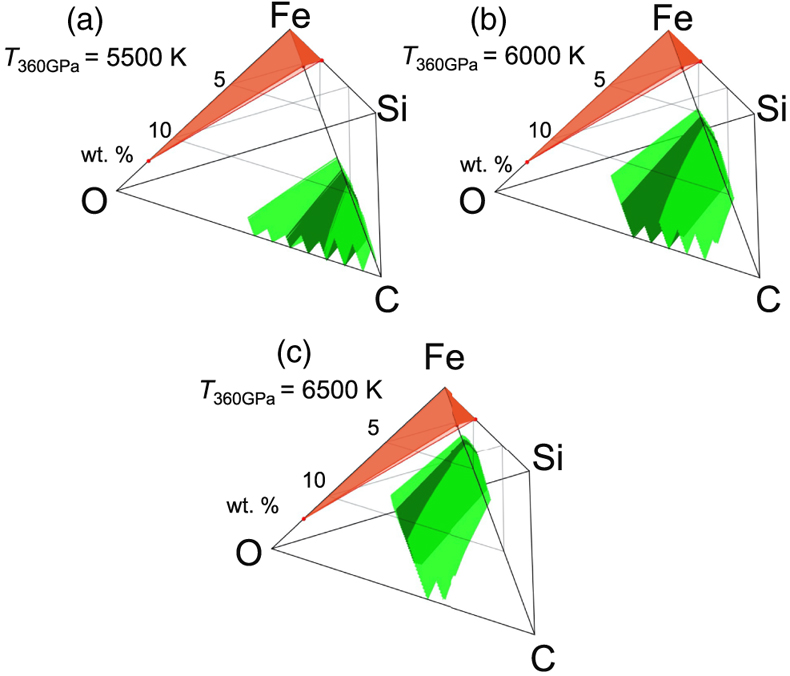
Figure 4 Compositional range of liquids (green) that are in equilibrium with the Fe-C-Si-1.4 wt. % S solids for the inner core proposed by Li et al. (2018)
Li, Y., Vočadlo, L., Brodholt, J.P. (2018) The elastic properties of hcp-Fe alloys under the conditions of the Earth’s inner core. Earth and Planetary Science Letters 493, 118–127. https://doi.org/10.1016/j.epsl.2018.04.013
. Green and dark green areas indicate compositions estimated using DC with and without ±1σ uncertainty, respectively. T360 GPa = 5500 K (a), 6000 K (b), and 6500 K (c). The O contents are calculated to account for the outer density and velocity at corresponding TICB = 5320 K, 5800 K, and 6280 K (Umemoto and Hirose, 2020Umemoto, K., Hirose, K. (2020) Chemical compositions of the outer core examined by the first principles calculations. Earth and Planetary Science Letters 531, 116009. https://doi.org/10.1016/j.epsl.2019.116009
). The red area shows the liquidus field of Fe in the Fe-C-O-Si-1.7 wt. % S system. There are no Fe-C-O-Si-1.7 wt. % S liquids that satisfy both the seismological (green) and liquidus phase (red) constraints.

